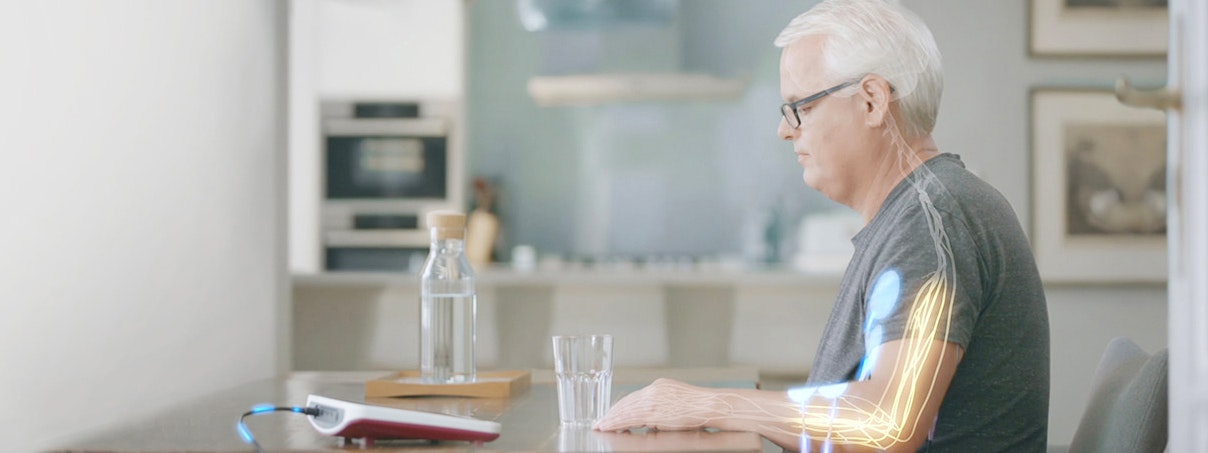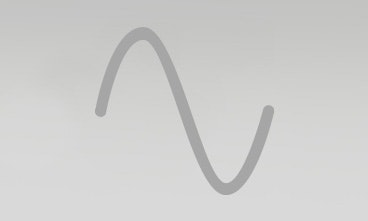Electrotherapy
Electrotherapy or electrical stimulation is the therapeutic application of electric current. Modern electrotherapy is primarily used to improve functions and activities. This is called functional electrical stimulation.
What is electrotherapy?
Electrotherapy is the therapeutic application of electricity. The electric current can be used in many ways by varying individual parameters. The therapy can focus on different outcomes, depending on the applied current form:
- Supporting learning of motor skills and functional rehabilitation
- Increasing independence and improving quality of life
- Re-learning everyday activities
- Reducing spasticity
- Promoting reinnervation for (partial) denervation
- Preventing or reducing muscle atrophy
- Improving coordination & perception
- Improving circulation
Electrotherapy is the term used in physical therapy for the therapeutic application of electrical impulses. Muscle activity in the body is normally controlled by the nervous system. The brain uses nerves to stimulate muscles by means of electrical signals which generate tension (contraction).
If parts of the nervous system (brain or nerves) are damaged, signal transmission may be impaired to such an extent that signals are either incomplete or do not reach the muscles at all. As a result, these muscles may be less tensioned, and muscle mass shrinks. Such damage may be caused, for instance, by a stroke, an accident, or an infection. Long periods of immobilisation, e.g. following surgery, can also cause a loss of muscle mass.
Electrotherapy can thus be used for rehabilitation in order to:
- learn or re-learn movements
- prevent loss of muscle mass (‘atrophy’)
- support regeneration of the nervous system
The device transfers electrical signals triggering muscle contractions through the skin to the muscle. Electrically conductive contact surfaces, known as electrodes, are applied to the skin for this purpose.
Modern electrical stimulation/electrotherapy is applied in a functional context (functional electrical stimulation), and thus aims to restore functions and motor learning in order to increase independence.

Functional electrical stimulation
Functional electrical stimulation (FES) is a subdivision of electrotherapy. It is used in the rehabilitation of patients with neurological and orthopaedic diseases/injuries in order to support the functions of muscles, nerves, and the brain.
Unlike classic electrical stimulation, FES treats several muscles sequentially, so that electrical impulses either assist a function or activity, or substitute it completely (van Kerkhof 2013).
EMG-triggered multi-channel electrical stimulation
In contrast to conventional electrotherapy devices, the STIWELL® electrical stimulation device is equipped with 4 stimulation channels, which enable stimulation of up to four muscle groups. As a result, it can systematically train even complex motion sequences. Individual muscles are electrically stimulated simultaneously or sequentially, which results in a complete movement.
The special feature of EMG-triggered multi-channel electrical stimulation is that it strengthens the patient's movement impulse, which is otherwise too weak, and the start of the stimulation is triggered by the patient himself. Electrical stimulation starts from a certain degree of muscle activity (e.g. by voluntary tensioning) once a previously defined threshold has been reached.
This threshold can be steadily adjusted in the course of therapy in order to achieve the best approximation of the original maximum strength. Thus the patient is made aware of even minimal therapeutic advances. The goal is to improve the patient’s
movement skills, and to improve his quality of life by increasing his independence with respect to his daily activities. The patient can actively train his voluntary movements and muscle strength.
Electrotherapy: Explanation of terms
Electrotherapy is based on the general modes of action of electric current, which is why they should be explained in more detail here.
Stimulation intensity
Symbol: I
Unit: A (ampere)
If electric charge carriers (electrons, ions) move, it is called electric current. The stimulation intensity is low or high depending on the concentration of charge carriers in a conductor (at a certain point in time).
Voltage
Symbol: U
Unit: V (volt)
Voltage relates to the movement of electric charge carriers between poles. Voltage is generated due to the excess of negatively charged electrons at the negative pole, which are pulled towards the positive pole, and vice versa. Electricity flows if there is a connection between the two poles.
Electrical resistance
Symbol: R
Unit: Ω (ohm)
Electrical resistance results from the connection between the two poles. When the voltage is high and the resistance is low, the current can flow easily. To regulate the current flow, a resistor is important for electronic devices.
Ohm's law
Formula: U = R × I
Ohm's law describes the relationship between stimulation intensity (current), voltage, and electrical resistance. If the resistance is increased, the voltage also increases. With constant voltage current types (denervated stimulation), the stimulation intensity decreases due to the increased resistance.
Amplitude
Amplitude is a term used in physics and mathematics to describe vibrations or the maximum displacement of a vibration. Depending on the size of the amplitude, electrical stimulation may provoke a sensory reaction (tingling) or a motor reaction (movement).
Frequency
Symbol: f
Unit: Hz (hertz)
Frequency indicates the number of vibrations a particle undergoes within a certain amount of time.
Electrotherapy: Current forms/types
Current can be alternating or direct, depending on whether it reverses its direction of flow (two-phase), or only flows in one direction (single-phase). In terms of frequency, the therapy can be low, medium, or high-frequency.
Direct current (galvanisation) and alternating current are used as forms of low-frequency current. DC therapy uses frequency-stabilised and frequency-modulated currents. In order to prevent skin damage, however, two-phase alternating currents are usually used. Since the focus is on motor stimulation here, a higher amplitude can be used. Depending on the degree of nerve damage, different types of current are used.
Medium-frequency currents are used in electrotherapy mainly for the treatment of pain and for motor stimulation. Electrotherapy includes high-frequency therapy, heat therapy (red light), and ultrasound therapy.
Triangular (exponential) current
-stiwell-neurotab.jpg?auto=format&sfvrsn=4724aa45_38)
Trapezoidal
current

Square wave
current

Medium frequency currents

Treatment method of functional electrical stimulation
Functional electrical stimulation (FES) is a stimulation of muscles or nerves with the aim of improving a function or activity. Multiple muscles can be stimulated through multiple channels to produce coordinated activity. FES can also be triggered by electromyography (EMG), which is referred to as EMG-triggered electrical stimulation. In this case, electrical stimulation is triggered when a specified activity threshold is exceeded. The device determines this by means of EMG measurement.
EMG measurement can also be used in isolation, without electricity, in the form of biofeedback therapy. Biofeedback training is used mainly for coordination training and training of specific movements.
Depending on the electrotherapy device used, it may have one or more of these functions. Electrical stimulation devices stimulate motor nerves to improve movement.
Areas of application of electrotherapy
Electrical stimulation is often used in combination with occupational therapy or physiotherapy. It is used on a regular basis for knee, shoulder, and back problems, as well as for almost all neurological diseases. Examples of diseases which can be treated with electrical stimulation:
Home-based electrotherapy

Functional electrical stimulation can also be used at home as a supplement to physiotherapy and occupational therapy.
Various electrical stimulation devices can also be used for home-based therapy after training by the physician or therapist providing the treatment. Regular training with functional electrical stimulation serves as a supplement to physiotherapy or occupational therapy.
Electrotherapy: Which patients should be treated with caution?
Factors that require caution when applying electric current are called absolute or relative contra-indications. Absolute contra-indications mean that the therapy should not be performed under any circumstances. Relative contra-indications mean that it may only be performed under certain circumstances or if precautions are taken. Some of these contra-indications are as follows:
- pacemakers
- cardiac arrhythmias
- seizures (uncontrollable epilepsy)
- open wounds in the application area
- tumours in the stimulation area
- pregnancy
Electrotherapy training
Therapists and physicians can attend additional training in the field of electrical stimulation. These training courses, especially in the field of functional electrical stimulation, are important because they are usually not part of the regular training curriculum. Regular refresher courses or webinars are also useful due to the increase in research in the field of functional electrical stimulation.
Avail of the comprehensive training material provided by STIWELL® Academy
Find out how functional electrical stimulation with the STIWELL®
can be used in the treatment of neurological & orthopaedic diseases!
